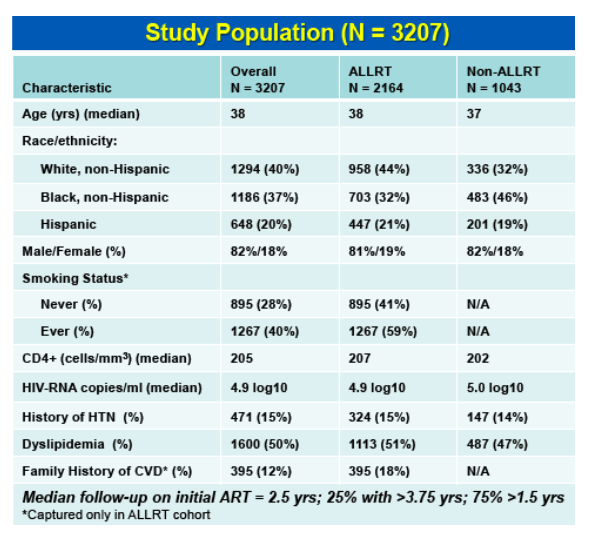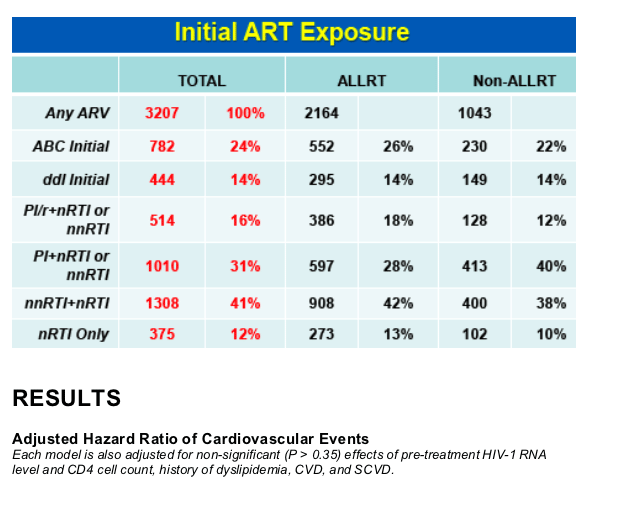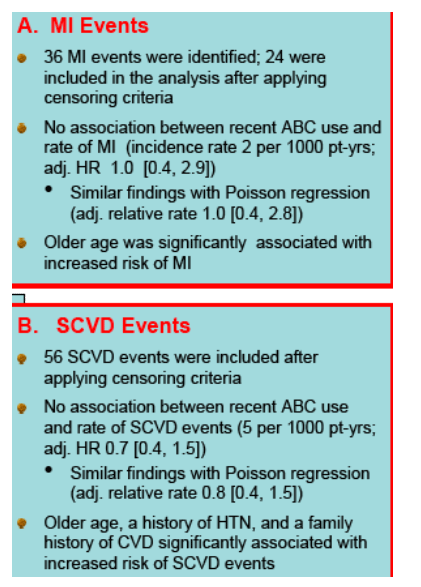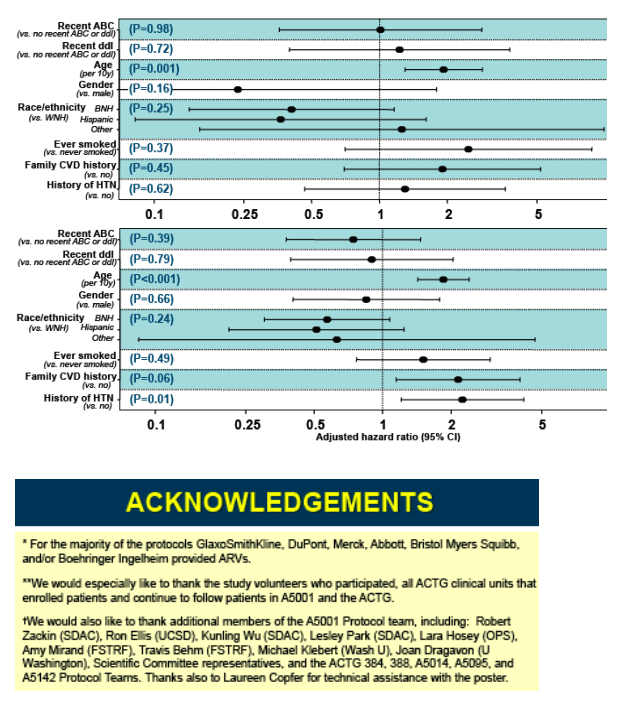 |
 |
 |
| |
No Association of Abacavir (ABC) Use with Risk of Myocardial Infarction (MI) or Severe Cardiovascular Disease Events (SCVD): Results from ACTG A5001/ALLRT
|
| |
| |
Reported by Jules Levin
CROI 2009 Feb 8-12 Montreal
Benson CA,1Ribaudo H,2Zheng E,2Koletar SL,3Collier A,4Smurzynski M,2Bosch R,2Bastow B,5Schouten J4for the ACTG A5001/ALLRT Protocol TeamAffiliations: 1Division of Infectious Diseases, University of California, San Diego, CA; 2Harvard School of Public Health, Boston, MA; 3 Division of Infectious Diseases, Ohio State University, Columbus, OH; 4School of Medicine, University of Washington, Seattle, WA; 5Social & Scientific Systems, Inc., Silver Spring, MD
"older age was significantly associated with increased risk of MI. Older age, a history of hypertension (HTN), and a family history of CVD significantly associated with increased risk of SCVD events"
AUTHOR SUMMARY & DISCUSSION
In contrast with the D.A.D. and SMART studies we did not find an association between recent abacavir use and risk of MI or SCVD event.
However, our data do not rule out an association between ABC and MI of the magnitude observed in D.A.D. (RR 1.92); the 95% CI for estimated relative rate of MI in our analysis included this value.
--Our data are not consistent with an association of ABC with a rate of MI of the magnitude reported in the SMART study or of an association between recent ABC use and the rate of SCVD of the magnitude described in both D.A.D. or SMART studies.
Possible explanations for the disparate findings across these studies:
Section biases (may have been partially mitigated in our analyses when ART exposure was randomized).
Limitations of our study:
-- Limited power for the association with MI giventhe small number of events (although the number is similar to that reported in the SMART study).
-- Consoring strategy used may have introduced bias if discontinuation of initial ABC was informative for the event of interest, i.e., for a subsequent CDV event; further analyses of our data usinf methods for causal inference (inverse probability weighting of censoring) is ongoing.
Population differences - compared with ALLRT, the D.A.D. and SMART cohorts:
-- Were older (median age 43 and 44 vs 38)
-- Had a higher proportion of whites in SMART (56% vs 40% in ALLRT; not reported in D.A.D.)
-- Had a higher proportion of subjects on lipid lowering agents at entry (12% and 16% vs 2% in ALLRT)
-- D.A.D. had a lower proportion of subjects with dyslipiemia (44% vs 50%) and a higher proportion with HTN (18% vs 15%.
ABSTRACT
Background: The D:A:D study reported that the recent use of ABC was associated with increased risk of MI; the SMART study noted a similar association with SCVD. We evaluated the association between ABC use and the risk of MI and SCVD after starting antiretroviral therapy (ART) in ART-naive HIV-infected patients (pts).
Methods: Data were analyzed from 3207 pts randomized to their first ART regimen (from Jules: the patients in this analysis were randmonized while they were not in DAD & the French cohorts) in one of five ACTG studies; extended follow-up (F/U) was available for 2164 pts through the ALLRT long-term protocol. F/U was censored at the first of off-study, death, initiation of non-randomized ABC or 6 months (mo) after the last visit or discontinuation of randomized ART (not including within class substitutions not involving ABC). Hazard ratio (HR) for recent ABC exposure adjusted for pre-treatment risk factors including gender, race/ethnicity, age, HIV-1 RNA level, and CD4 cell count, recent ddIuse, and classic risk factors for CVD(smoking, hypertension, dyslipidemia, CVD, and family history of CVD), were estimated with Cox proportional hazards regression. With F/U censored as described, randomization to ABC is interpreted as recent ABC exposure. MIs were included if assessed as definite or probable by two independent reviewers.
Results: 3207 patients were included; 781 pts were randomized to ABC. 56 SCV Devents were reported including 24 MI. Significant associations between either MI or SCVD and recent ABC exposure were not detected in adjusted analyses (1.01, 95% CI, [ 0.36, 2.85]; Figure 1). Significant increases in the risk of events were detected for some classic CVD risk factors, i.e., older age and HTN (see Figure A/B).
Conclusions: In contrast to D:A:D and SMART, we did not find a significant association between recent ABC use and MI or SCVD risk for ART-naïve pts randomized to an initial ABC regimen. Our results suggest the association with recent ABC use in other studies may be a marker for other factors not discerned in their analyses.
INTRODUCTION AND BACKGROUND
Analyses of the D:A:D cohort and of the continuous ART arm of the SMART study found an association between the recent use of ABC and the rate of MI (relative risk 1.89 [1.47, 2.48] and 4.3 [1.4, 13.0], respectively) and SCVD events (relative risk 1.63 [1.3, 2.04] and 1.8 [1.0, 3.1], respectively)1,2
-- Potential limitations with the D:A:D and SMART analyses include:Underestimated event rates for older thymidineanalogs due to inclusion of ART exposure prior to cohort entry but without capture of pre-entry CVD events.
-- Formal causal inference methodology has not yet been applied to analyses to mitigate channeling bias.
Pooled data from 54 clinical trials, in which ABC-treated and ABC-untreated subjects were compared, failed to demonstrate an association of ABC with increased rate of MI (RR of MI with ABC 0.86 [0.40, 1.86])3
To further evaluate the possible relationship of ABC exposure and CVD risk, we undertook an analysis of subjects randomized to initial ART with or without ABC in their original regimen in the context of AIDS Clinical Trials Group (ACTG) trials from 1998-2004.4
1D:A:D. Lancet2008; 371:1417-26; 2SMART. AIDS2008; 22:F17-F24; 3Cutrell A, et al., Abstr. WEAB1016, IAS 2008; 4ALLRT. HIV ClinTrials2008; 9:269-82.






|
| |
|
 |
 |
|
|